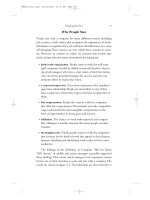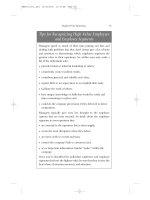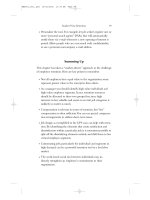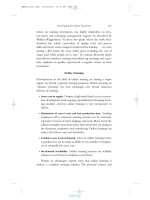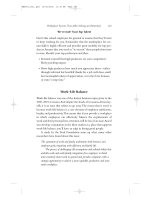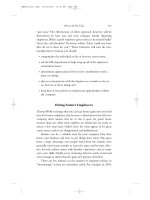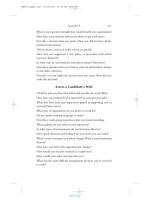Hiring and Keeping the Best People 20
Bạn đang xem bản rút gọn của tài liệu. Xem và tải ngay bản đầy đủ của tài liệu tại đây (104.44 KB, 8 trang )
“got away.” The effectiveness of either approach, however, will be
determined by how you and your company handle departing
employees.When a good employee gives notice, is he treated badly?
Given the cold shoulder? Do bosses whine, “How could you leave
after all we’ve done for you?” Those behaviors will sour the rela-
tionship forever. Instead, you should:
•
congratulate the individual on his or her new career move;
•
ask the HR department to help wrap up all of the departee’s
termination issues;
•
demonstrate appreciation for his or her contributions with a
party or outing;
•
plan to communicate with the departee in a month or two to
see how he or she is doing; and
•
keep him or her posted on employment opportunities within
the company.
Hiring Former Employees
Thomas Wolfe’s message that you can’t go home again does not hold
true for former employees. Just because a valued person has left your
company, don’t assume that he or she is gone for good. Some
women drop out while their children are infants but are ready to
return a few years later. Others leave for what appear to be great
career moves, only to be disappointed and disillusioned.
Rehires can be a valuable asset for your company. First, they
know your business and how to get things done there. This gives
them a huge advantage over people hired from the outside, who
generally need many months to learn the ropes and become effec-
tive. Second, rehires return with broader experience and, in many
cases, new skills. Finally, every returning defector sends a loud and
clear message to others that the grass isn’t greener elsewhere.
There are few statistics on the number of employee rehires, or
“boomerangs” as they are sometimes called. For example, in 2000,
When All Else Fails 139
HBE001_ch7_.qxd 10/02/2002 11:44 AM Page 139
the accounting firm of Ernst & Young claimed on its Web site that
nearly 25 percent of its customer-serving new hires in North Amer-
ica were former employees. During the following year—when most
companies weren’t hiring anyone—Ernst & Young made a special
effort to re-recruit good IT employees who had defected to now-
defunct dot-com companies. It even set up a national Alumni Rela-
tions Office to manage this important aspect of its human resource
business.
2
Here are a few things you can do to increase the number of
employee rehires:
•
Cure the problems that made them leave in the first place. Exit
interviews and direct investigation are the best ways to deter-
mine the root causes of defection. If you find that a bad
regional manager has been driving his most capable sales peo-
ple away, replace that manager—and then invite the best of the
defectors to return.
•
Keep the lines of communication open between your firm and
the best of its departed employees. Use some of the alumni
relations tactics cited above. Communicate with them periodi-
cally, ask about how they’re doing in their new jobs, and keep
them up to date concerning job openings at your company.
•
Make re-employment as easy as possible.There’s a certain
amount of discomfort involved with returning to one’s old
company. Eliminate that discomfort through public statements
that “Our door is always open to valued former employees.”
Celebrate each return, just as you would the return of a former
customer.“We’re glad you’re back!”
Perhaps the biggest and most celebrated rehire in recent memory
was Apple Computer’s rehiring of departed founder Steve Jobs. Jobs
returned to his former post older, more experienced, and undoubt-
edly wiser, and his return marked the beginning of an important
revitalization for the then-beleaguered company.
It’s unlikely that any one of your rehires will have the impact
that Steve Jobs had on Apple, but you’ll know a great deal about the
140 Hiring and Keeping the Best People
HBE001_ch7_.qxd 10/02/2002 11:44 AM Page 140
person you’re getting, and the hiring outcome is more likely to be
more successful than if you hired an unknown off the street.
Exit Interviews
Most HR departments conduct exit interviews with departing
employees, either directly or through questionnaires. The aim of
these interviews is to get feedback about the firm, its operations, the
root causes of turnover, and the performance of its managers from
people who now have less reason to hedge or conceal their views.
If your company isn’t doing this—or not doing it in a serious or
systematic way—insist on a change.At a minimum, an exit interview
should seek answers to these questions:
•
What originally attracted you to this company?
•
How satisfied were you with employment here (on a 1-5
scale)?
•
How would you assess your boss or supervisor (again, on a 1-5
scale on various dimensions: ability to communicate, leadership,
fairness, employee development, etc.)?
•
Why are you leaving? (if the exit is voluntary)
•
Would you consider applying for another job here in the
future?
•
How could we make this a better place to work?
The responses gathered through many exit interviews can help you
identify the root causes of turnover and build a solid strategy for
improved retention. In this sense, information gleaned from exit
interviews is an important part of continuous workplace improve-
ment. Chances are your company seeks the root causes of below-
standard output elsewhere in the organization—on the production
floor, in customer service levels, and so forth—with a goal to
improve process quality. What departing employees tell you should
be used in the same way.
When All Else Fails 141
HBE001_ch7_.qxd 10/02/2002 11:44 AM Page 141
Summing Up
Acknowledging that employee turnover is inevitable, this chapter
has offered three ways to potentially benefit from departing em-
ployees:
•
Keep up contact and good relationships with company alumni;
doing so can sometimes provide your company with new
business, market intelligence, and, in some cases, rehires.
•
View highly valued former employees as potential rehires; in
most cases, a former employee returns with broader experience
and new skills—both of which can benefit your company.
•
Use exit interviews to obtain as much information as possible
about the root causes of employee turnover.
142 Hiring and Keeping the Best People
HBE001_ch7_.qxd 10/02/2002 11:44 AM Page 142
appendix a
Sample Job Description
A job description is a profile of a particular job, its essential func-
tions, reporting relationships, hours, and required credentials. It
identifies what the job-seeker agrees to do in return for pay and
benefits. Rather than focusing on how an employee should spend
his or her time, a good job description should focus on performance
and the results the company expects in the bargain.What will success
look like? How will it be measured? How should the employee’s
work affect the mission and needs of the company? It is also an
attempt to describe the qualifications needed to perform the job.
The sample represented below contains the basic elements you
should include in job descriptions you develop.
Should you reveal the salary range in the job description? Many
employers are reluctant to do this because of fear of offending exist-
ing employees, preferring to veil uneven hiring practices.This is not
only bad management, in the United States it is also potentially ille-
gal if it indicates that you are not offering equal pay for equal work.
For your convenience, you can use the “Job Profile” form to
develop job descriptions for your open positions.
143
HBE001_AppA_.qxd 10/02/2002 11:45 AM Page 143
